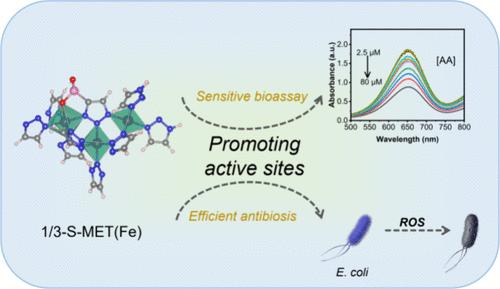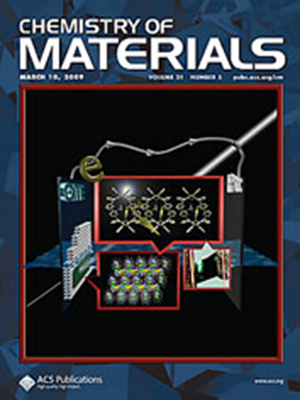S 掺杂铁-三唑烷金属有机框架纳米酶:配体工程高效过氧化物酶模拟物
IF 7.2
2区 材料科学
Q2 CHEMISTRY, PHYSICAL
引用次数: 0
摘要
基于金属有机框架(MOF)的纳米酶在生物催化领域引起了广泛关注。本研究通过配体调控策略制备了一种基于MOF的纳米酶。首先,采用溶热法合成了具有 Fe-N 结构的三氮杂环铁(MET(Fe))纳米酶。然后,通过混合配体生长法引入不同比例的含硫配体,得到一系列掺杂S的MET(Fe)(S-MET(Fe))纳米酶。含硫配体会竞争性地与铁而不是三唑醇配位,形成"-C-SOx "键,从而产生更多的氧缺陷。对催化机理的研究表明,S 的掺杂影响了 Fe 的催化活性中心,导致产生 FeIII 的中等自旋物种和更多配位缺陷,从而提高了其催化活性。作为概念验证,1/3-S-MET(Fe)纳米酶具有突出的过氧化物酶样活性,被用于生物传感和消灭细菌。这项研究为设计和构建高活性纳米酶提供了新思路。本文章由计算机程序翻译,如有差异,请以英文原文为准。

S-Doped Iron-Triazolate Metal–Organic Framework Nanozymes: Ligand-Engineered High-Efficiency Peroxidase Mimics
Metal–organic framework (MOF)-based nanozymes have aroused wide interest in biocatalysis. In this work, a kind of MOF-based nanozymes were fabricated through a ligand regulation strategy. First, an iron-triazolate (MET(Fe)) nanozyme with the Fe–N structure was synthesized by the solvothermal method. Then, different proportions of the sulfur-containing ligand were introduced by the the mixed-ligand growth method to obtain a series of S-doped MET(Fe) (S-MET(Fe)) nanozymes. The S-containing ligand would competitively coordinate with Fe instead of triazolate, forming a “–C–SOx” bond and thereby resulting in more oxygen defects. The investigation of the catalytic mechanism showed that the doping of S affected the catalytic activity center of Fe, resulting in the generation of medium-spin species of FeIII and more coordination defects, thereby enhancing its catalytic activity. As a proof of concept, the 1/3-S-MET(Fe) nanozyme with outstanding peroxidase-like activity was used in biosensing and in the elimination of bacteria. This study provides new ideas for the design and construction of highly active nanozymes.
求助全文
通过发布文献求助,成功后即可免费获取论文全文。
去求助
来源期刊

Chemistry of Materials
工程技术-材料科学:综合
CiteScore
14.10
自引率
5.80%
发文量
929
审稿时长
1.5 months
期刊介绍:
The journal Chemistry of Materials focuses on publishing original research at the intersection of materials science and chemistry. The studies published in the journal involve chemistry as a prominent component and explore topics such as the design, synthesis, characterization, processing, understanding, and application of functional or potentially functional materials. The journal covers various areas of interest, including inorganic and organic solid-state chemistry, nanomaterials, biomaterials, thin films and polymers, and composite/hybrid materials. The journal particularly seeks papers that highlight the creation or development of innovative materials with novel optical, electrical, magnetic, catalytic, or mechanical properties. It is essential that manuscripts on these topics have a primary focus on the chemistry of materials and represent a significant advancement compared to prior research. Before external reviews are sought, submitted manuscripts undergo a review process by a minimum of two editors to ensure their appropriateness for the journal and the presence of sufficient evidence of a significant advance that will be of broad interest to the materials chemistry community.
 求助内容:
求助内容: 应助结果提醒方式:
应助结果提醒方式:


